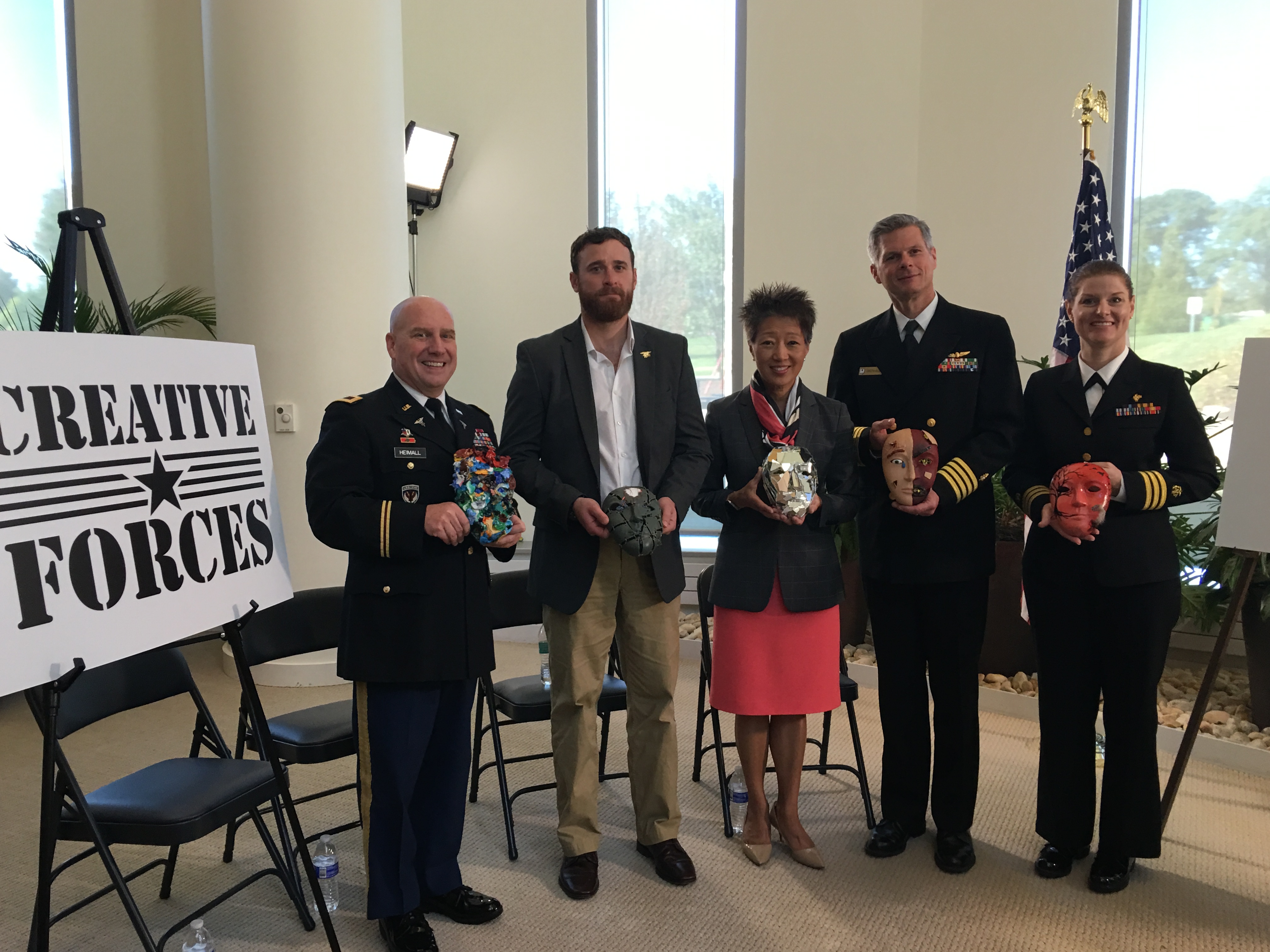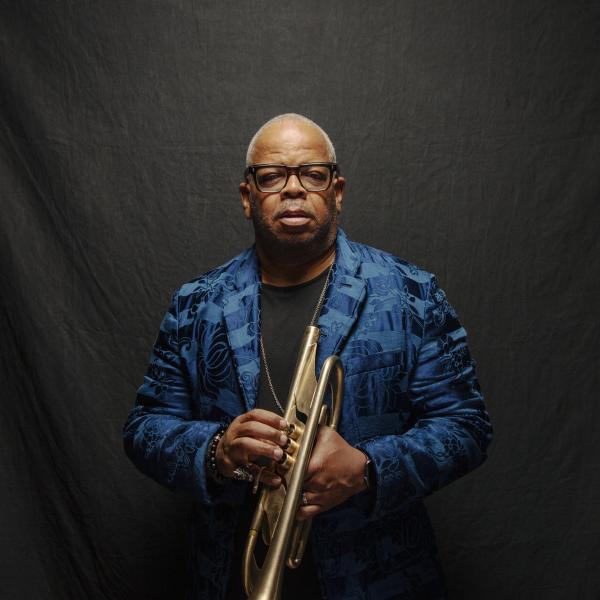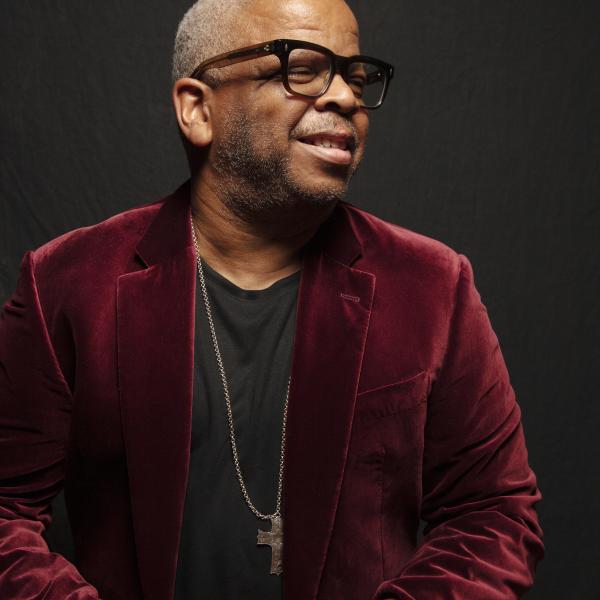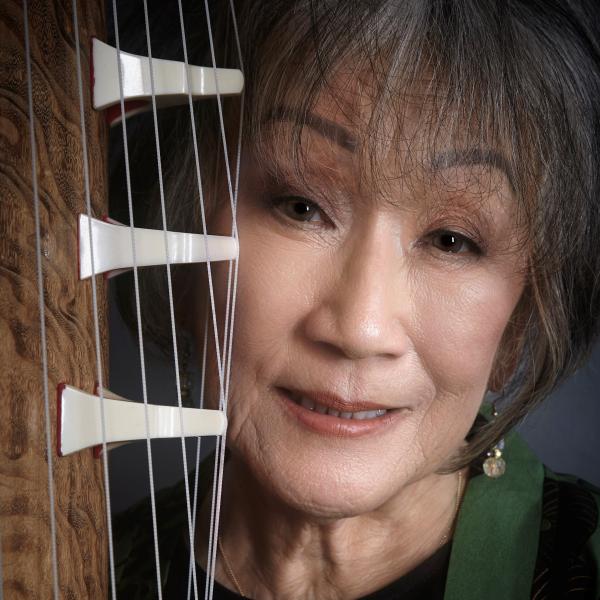Take a Listen Inside Creative Forces

(From left) At an October 2016 press event at the National Intrepid Center of Excellence at Walter Reed National Military Medical Center are: Colonel Michael S. Heimall, Director, Walter Reed National Military Medical Center; Mr. Rusty Noesner, Retired, US Navy SEAL; Jane Chu, Chairman, NEA; Captain Walt Greenhalgh, Director, National Intrepid Center of Excellence (NICoE) and Commander Wendy Pettit, Chief of Clinical Operations, National Intrepid Center of Excellence (NICoE) holding up masks made by service men and women in the Creative Forces program.
The National Intrepid Center of Excellence, or NICoE, a state of the art facility on the Walter Reed campus, was the first clinical site in the Creative Forces Network. Larry Miller is a physician assistant and retired Navy Commander who practices at the James A. Haley VA. When he was on active duty—he was assigned to the NICoE. Larry Miller
Larry Miller: I’ve had the absolute privilege of working and helping establish the NICoE, which is the National Intrepid Center of Excellence. I worked with Dr. Jim Kelly at Walter Reed and helped develop that program so that was something that was near and dear to my heart. In that program, they have a fantastic art and music program. I could tell you that at the beginning being a hard-charging emergency medicine, general surgery-type guy art therapy seemed a little fluffy to me but I quickly became a believer when I saw some of the results and talked to some of and talked to some of the patients that were there, in particular the special operations folks and that community. They were able to open up in a whole other dimension from what they were able to do in their just normal therapies.
Jo Reed: Rusty Noesner is a former Navy Seal who experienced blast concussions and other blows to the head while he was serving in Afghanistan. After deployment—when he was experiencing some symptoms of TBI—irritability anxiety isolation and so on…he was sent to the NICoE for treatment…He arrived a sceptic about art therapy.
Rusty Noesner: I was resistant to art therapy it, but it took a while to kind of drop that shield a little bit, and then you realize how effective it is and how important it is for your cognitive processes in order to say "No, actually it's helping me process, it's helping me focus, it's helping me do a lot of other things that I took for granted."
Jo Reed: Larry Miller understands from a practitioner’s viewpoint how valuable a tool art therapy can be
Larry Miller: The challenges of taking care of mild-to-moderate TBI patients is vast and quite enormous. I feel the arts in brain injury brings a whole another dynamic to the picture. Well, currently at James A. Haley we have a-- recreational therapy and a psychologist and a occupational therapist that does some art therapy. The National Endowment for the Arts has agreed to send us a board-certified art therapist and we are ecstatic about trying to implement that program.
Jo Reed: Rusty Noesner
Rusty Noesner: And art therapy really, really spoke to me, : I don't think it's necessarily like a light bulb switching on. It's more actually like a light bulb fluttering to life.
Larry Miller: They were able to open up in a whole another dimension They learned a lot about themselves through what they were creating in art and it allowed the therapists to help analyze from a different perspective - and tailor their care. It’s fantastic.
Jo Reed: An important leg in the Creative Forces program is building and supporting community-based Arts Programming at each of the 11 clinical sites. Creative Forces is bringing State agencies and local arts organizations together with the military to tailor arts programming that support not just military members, and veterans but their families as well
Margi Vanderhye is Executive Director of the Virginia Commission for the Arts. Virginia is the home to one of first clinics in the creative forces network—at Fort Belvoir as well as the most recent at Joint Expeditionary Base - in the Hampton Roads area.
Margi Vanderhye: Community-based arts programming is essential because many of the people who are involved and benefit from it have lived in many places. For them the sense of community is even more compelling because the great dislocation that they have sustained both in terms of the distress from deployments, whatever they may have endured in those deployments, and the reentry and reintegration into a more permanent, more normal shall we say sense of community can be a very different and difficult transition.
Jo Reed: Margi Vanderhye is certain that arts programming will serve as a bridge not only to continuing wellness but also to fuller community engagement.
Margi Vanderhye: The National Endowment for the Arts has had the vision and the guidance to work with state partners and recognize that both active-duty and veteran populations can benefit tremendously in terms of their well-being, their reintegration through art and art-related programs. . And I think one of the real assets of this Creative Forces expansion program is the ability to see that and to provide those-- the avenues for people both in civilian life and in military and veteran populations to get there.
Jo Reed For more information about creative forces, go to arts.gov—for the National Endowment for the Arts, I’m Josephine Reed.
Today, we are announcing new investments in Creative Forces: NEA Military Healing Arts Network. Four clinical sites will join the seven current members, the community component is getting off the ground, and a tele-health program is coming on board as well.
As part of the announcement, we are sharing some thoughts of several people involved with Creative Forces and creative arts therapies in the military. Have a listen.




